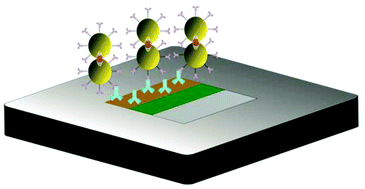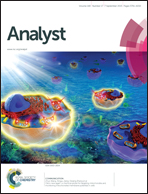Carboxy-terminated immuno-SERS tags overcome non-specific aggregation for the robust detection and localization of organic media in artworks†
Abstract
Methods combining immunology and surface-enhanced Raman scattering (SERS) have been developed for the simultaneous detection, identification, and localization of proteinaceous binding media found in artworks. However, complex surface topographies and heterogeneous compositions of art samples represent significant challenges for the general optimization of this technique. In particular, aggregation of immuno-SERS nanoparticles can lead to non-specific SERS response across the sample surface, resulting in inaccurate identification of binding media or dubious localization maps. This aggregation also diminishes the sample area available for analysis, as excitation of visible nanoparticle aggregates by the Raman laser must be avoided during data collection. In the present work, we synthesize several types of immuno-SERS nanoparticles and investigate their applicability for the detection and localization of ovalbumin-rich (egg-based) binding media in art samples. Dimers of gold nanoparticles (Au NPs) connected by a Raman-active dithiolated linker are conjugated to secondary antibodies through either an amino or a carboxyl functional group (SERS tags). The SERS tags display localized surface plasmon resonance (LSPR) at 532 nm. SERS spectra are acquired at 633 nm (SERS-633) in order to maximize tuning between laser excitation and LSPR, while avoiding sample burning. In an indirect immunoassay applied to replica art samples, carboxy-terminated SERS-633 tags show strong Raman reporter signal, specificity for the target protein, robust response in the presence of various inorganic pigments, and reduced aggregation on sample surfaces compared to amino-terminated or commercial SERS tags. Scanning electron microscopy (SEM) is used to visualize Au NPs bound to egg media in situ, demonstrating that carboxy-terminated SERS-633 tags remain as discrete dimer units throughout the assay.



 Please wait while we load your content...
Please wait while we load your content...